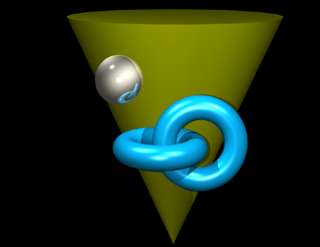Stony Brook UniversityMAT 645 Topics in Differential Geometry
Spring 2007 |

|
|---|
Metric Foliations and Curvature

Stony Brook UniversityMAT 645 Topics in Differential Geometry
Spring 2007 |

|
|---|

Lecturer:
Detlef Gromoll, Math 5-110
Phone: 632-8286,
Email: detlef@math.sunysb.edu
Classes: TuTh 2:20-3:40, Mathematics 5-127
Office Hours: By appointment
About this Course: Our discussion of topics will be based on an advanced draft of a new book with the same title by Gerard Walschap and myself. Copies of the manuscript will be available to students in the course.
Metric foliations arise as locally everywhere equidistant partitions by submanifolds (often with focal singularities), primarily in riemannian geometry. They globalize riemannian submersions. Basic examples are orbit foliations under isometric group actions.
The geometry of metric foliations has emerged as a fundamental aspect of understanding the structure of manifolds with curvature constraints. Ever since Samelson ond O'Neill observed that riemannian submersions are horizontally curvature nondecreasing, there has been great effort - and recently much success - in using submersions beyond the homogeneous case for the construction of examples of spaces with controlled curvature, an important and broad task, which is notoriously difficult. By nature, the approach is most effective in the study of nonnegative sectional and ricci curvature. The work of Grove-Ziller, Wilking, and many others on cohomogeneity 1 manifolds during the last decade is a good example. The deformation theory of riemannian submersions can be called the study of general warped metrics. It provides a rich source of construction tools, but computations and estimates tend to be quite delicate.
Perelman's strengthening of the Soul Theorem (complete manifolds of nonnegative sectional curvature are actually metric fibrations over their souls) has opened a wide new range of questions, with focus on the geometry of nonnegatively curved metrics on vector bundles (intriguing already over round spheres), rather than just on their topology, which is also not fully understood yet at all. We will touch on various such problems.
There are many other beautiful topics in this direction we might discuss, like the local and global structure of metric foliations in spaces of constant curvature, including the rigidity of Hopf fibrations.
Prerequisites include a certain familiarity with riemannian geometry and the basics about Lie groups.
Special Needs:
If you have a physical, psychological, medical or learning disability that
may impact your course work, please contact Disability Support Services,
ECC (Educational Communications Center) Building, room 128, (631) 632-6748.
They will determine with you what accommodations are necessary and
appropriate. All information and documentation is confidential.
Students requiring emergency evacuation are encouraged to discuss their
needs with their professors and Disability Support Services. For procedures
and information, go to the following web site.
http://www.stonybrook.edu/facilities/ehs/fire/disabilities.shtml
Check for updates and announcements regularly.